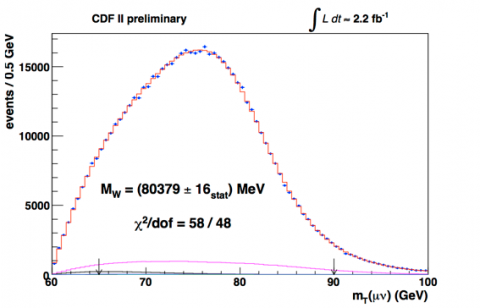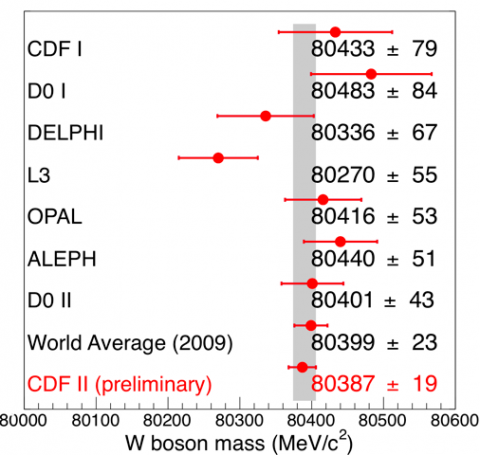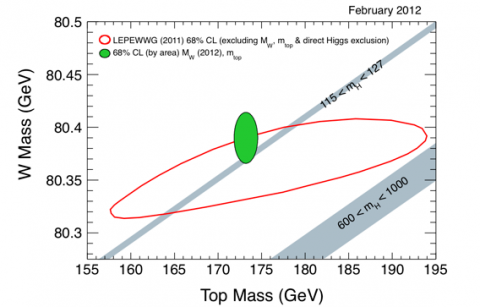


Fermilab's CDF experiment makes world's most precise measurement of W boson mass
It is through radiative quantum loop corrections that the W boson mass is sensitive to yet unobserved particles. Therefore, the observed mass of the W can be used to set a significant constraint on the mass of the Higgs boson. In fact, the W boson mass is currently the most sensitive input to the electroweak precision measurements that are used for the indirect Higgs boson mass prediction. By measuring the W boson mass very precisely and accounting for all known particle corrections in the theoretical prediction, one can solve for correction that originates from the Higgs boson.
This morning, Fermilab's CDF experiment released its new measurement of the W boson mass using 2.2/fb of proton-antiproton collision data, which yield Mw = 80387+-19 MeV (i.e., a precision of 2.4 parts in 10000). This measurement improves significantly on the D0 measurement that had an uncertainty of 43 MeV and in fact is more precise than the previous combined world average that had an uncertainty of 23 MeV and included measurements from CERN's LEP experiments as well as previous Tevatron measurements. The new resulting Higgs boson constraint finds a most probable value of mH = 92+34-26 GeV with an upper bound of mH < 145 GeV (the earlier upper limit was 161 GeV) at the 95% C.L. This confirms previous Higgs mass constraints in favoring a relatively low Higgs boson mass, but with higher precision.
Although the Tevatron accelerator at Fermilab has turned off, the particle-physics experiments are still analyzing data and refining their analyses. Elsewhere at the lab, new projects involving the "intensity frontier" and the "cosmic frontier" are underway alongside developments in basic accelerator science and technology.
TRIUMF research scientist Oliver Stelzer-Chilton has been a crucal player in the W boson mass determination for many years. He spent most of his doctoral and post-doctoral research on this topic and lead the CDF W boson mass working group for several years before joining TRIUMF. "This is a tremendous scientific measurement, the achieved precision is significant and it is exciting that the resulting Higgs constraint is compatible with the small mass region of 114-127 GeV that is not yet excluded by the LHC experiments" said Stelzer-Chilton who also works on direct searches for the Higgs boson on ATLAS.
"The year 2012 will be the year of the Higgs," said Nigel Lockyer, director of TRIUMF and a former spokesperson of the CDF experiment. "This measurements shows how powerful the Standard Model is; we can make a measurement over here that actually constrains what we don't know over there. It's exciting because either our model is wrong or we're within a year of metaphorically holding the Higgs in the palm of our hand." When working with CDF, Lockyer helped build the drift chamber, one of the particle detectors crucial for this analysis.
Stelzer-Chilton will be giving a seminar at TRIUMF next week on the results. More information can be found at: http://www-cdf.fnal.gov/physics/ewk/2012/wmass/
--by Oliver Stelzer-Chilton, TRIUMF research scientist, and T.I. Meyer, Head, Strategic Planning & Communication
